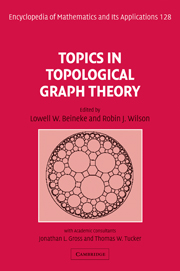Book contents
- Frontmatter
- Contents
- Foreword
- Preface
- Introduction
- 1 Embedding graphs on surfaces
- 2 Maximum genus
- 3 Distribution of embeddings
- 4 Algorithms and obstructions for embeddings
- 5 Graph minors: generalizing Kuratowski's theorem
- 6 Colouring graphs on surfaces
- 7 Crossing numbers
- 8 Representing graphs and maps
- 9 Enumerating coverings
- 10 Symmetric maps
- 11 The genus of a group
- 12 Embeddings and geometries
- 13 Embeddings and designs
- 14 Infinite graphs and planar maps
- 15 Open problems
- Notes on contributors
- Index
4 - Algorithms and obstructions for embeddings
Published online by Cambridge University Press: 05 June 2012
- Frontmatter
- Contents
- Foreword
- Preface
- Introduction
- 1 Embedding graphs on surfaces
- 2 Maximum genus
- 3 Distribution of embeddings
- 4 Algorithms and obstructions for embeddings
- 5 Graph minors: generalizing Kuratowski's theorem
- 6 Colouring graphs on surfaces
- 7 Crossing numbers
- 8 Representing graphs and maps
- 9 Enumerating coverings
- 10 Symmetric maps
- 11 The genus of a group
- 12 Embeddings and geometries
- 13 Embeddings and designs
- 14 Infinite graphs and planar maps
- 15 Open problems
- Notes on contributors
- Index
Summary
This chapter gives a brief introduction to algorithms for finding embeddings of graphs in surfaces and discusses obstructions that prevent a graph from having an embedding. It starts with questions related to planarity and continues with obstructions to outerplanar graphs and the 2-path problem. Algorithms and obstructions for embeddings of graphs in surfaces of higher genus are more complicated, and known results are surveyed.
Introduction
In this chapter we study the theory of embeddings of graphs in surfaces, algorithms for finding embeddings, and the related questions about obstructions for the existence of embeddings. These are interesting from the theoretical viewpoint in mathematics and in theoretical computer science and appear in the study of algorithms and computational complexity. But these results are important also in the treatment of some practical problems.
Planar graphs and their drawings in the plane occur naturally in a variety of applications. With the theoretical developments of computer science, graph planarity has received central attention in several areas of research.
Information
- Type
- Chapter
- Information
- Topics in Topological Graph Theory , pp. 62 - 80Publisher: Cambridge University PressPrint publication year: 2009
Accessibility standard: Unknown
Why this information is here
This section outlines the accessibility features of this content - including support for screen readers, full keyboard navigation and high-contrast display options. This may not be relevant for you.Accessibility Information
- 1
- Cited by
